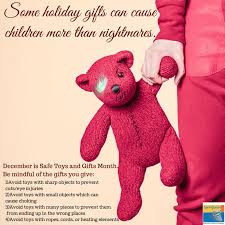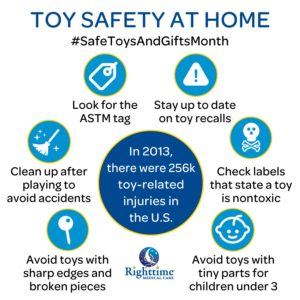When it comes to toys and gifts, it is critical to remember to consider the safety and age range of the toys.
Prevent Blindness America has declared December as Safe Toys and Gifts Awareness Month. The group encourages everyone to consider if the toys they wish to give suits the age and individual skills and abilities of the individual child who will receive it, especially for infants and children under age three.
This holiday season (and beyond), please consider the following guidelines for choosing safe toys for all ages:
- Inspect all toys before purchasing. Avoid those that shoot or include parts that fly off. The toy should have no sharp edges or points and should be sturdy enough to withstand impact without breaking, being crushed, or being pulled apart easily.
- When purchasing toys for children with special needs try to: Choose toys that may appeal to different senses such as sound, movement, and texture; consider interactive toys to allow the child to play with others; and think about the size of the toy and the position a child would need to be in to play with it.
- Be diligent about inspecting toys your child has received. Check them for age, skill level, and developmental appropriateness before allowing them to be played with.
- Look for labels that assure you the toys have passed a safety inspection – “ATSM” means the toy has met the American Society for Testing and Materials standards.
- Gifts of sports equipment should always be accompanied by protective gear (give a helmet with the skateboard)
Toy Guidelines
Here are some general guidelines to keep in mind when shopping for toys:
- Toys made of fabric should be labeled as flame resistant or flame retardant.
- Stuffed toys should be washable.
- Painted toys must use lead-free paint.
- Art materials should say nontoxic.
- Crayons and paint should say ASTM D-4236 on the package – which means that they they’ve been evaluated by the American Society for Testing and Materials.
- Try to steer clear of older toys, even some hand-me-downs from friends and family as these might not meet the current safety standards.
- Make sure the toy isn’t too loud – the noise of some rattles, squeak toys, and musical or electronic toys can be as loud as a car horn or even louder if the child holds it directly to their ear, which can damage hearing.
The Right Toys for the Right Age
When buying a gift or toy for a child, always read the label to make sure the toy is appropriate and safe for their age. Also, consider your child’s temper, habits, and behavior before buying a new toy. Children who can seem advanced compared to other children of their age, shouldn’t use toys meant for older kids. Age level toys are determined by safety factors, not intelligence or maturity.
Babies – babies about 4 months old begin to reach for and grasp objects. By 6 or 7 months, they can switch between hands. At 9 months, they can pick up smaller objects, like blocks. Some smart toys for babies could include a nursery mobile, a ring stack toy, and push-pull toys.
Toddlers – Toddlers start to become aware of the function of objects. They like to stack blocks, babble into toy phones, drink from “big kid” cups, and the pretend play starts now. Smart toys for toddlers could be balls, shape-sorting toys, mechanical toys, or role-play toys like play kitchens, toy doctor’s kits, and child golf sets.
Pre-school – preschoolers are at the age and development level of using objects for their intended purpose. Often, they may have imaginary friends or fantasy worlds that they play in. This is also the period where they will be learning new little tricks and connecting with other children. Safe toys and gifts for children of this age could consist of arts and crafts, blocks and construction sets, puzzles and other games.
Elementary School – Children of this age group have begun to grasp an understanding of the world around them and start to show talents and interests. Physical abilities and motor skills are being refined during this age and peer relationships take on a larger importance. Some smart toy and gifts options could include a jump rope, or other physical activity toys, card and board games, musical instruments, and science toys.
Safety tips to keep in mind this holiday season
When picking out toys and gifts for your children, you should not only consider what is appropriate for their age and ability, but you should also keep in mind safety tips for that age range and toy. A toy could be the perfect fit for their age and development, but there are still safety factors that need to be evaluated.
Giving your children a safe holiday season can be achievable by taking the proper precautions. You’ll be able to better protect your child from toy-related injuries by providing safe toys, environments, and adult supervision for when they open and play and with their toys.
Too often, accidents involving children and toys occur and may result in eye injuries. Each year, thousands of children age 14 and younger suffered serious eye injuries, even blindness, from toys.
There are three important ways you can protect your child’s eyes from injuries while playing with toys:
- Again, only buy toys meant for their age.
- Show them how to use their toys safely.
- Keep an eye on them when they play.

